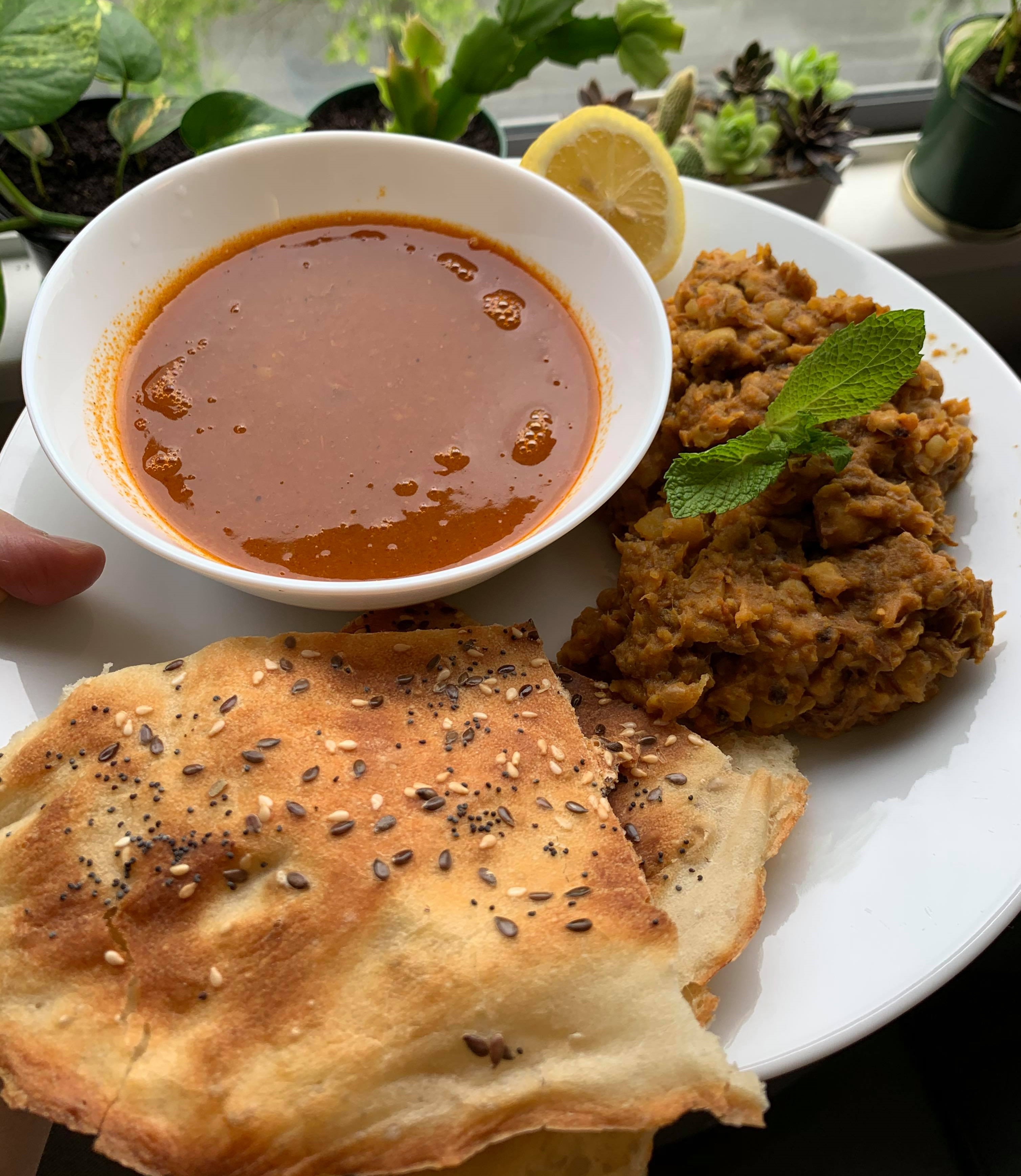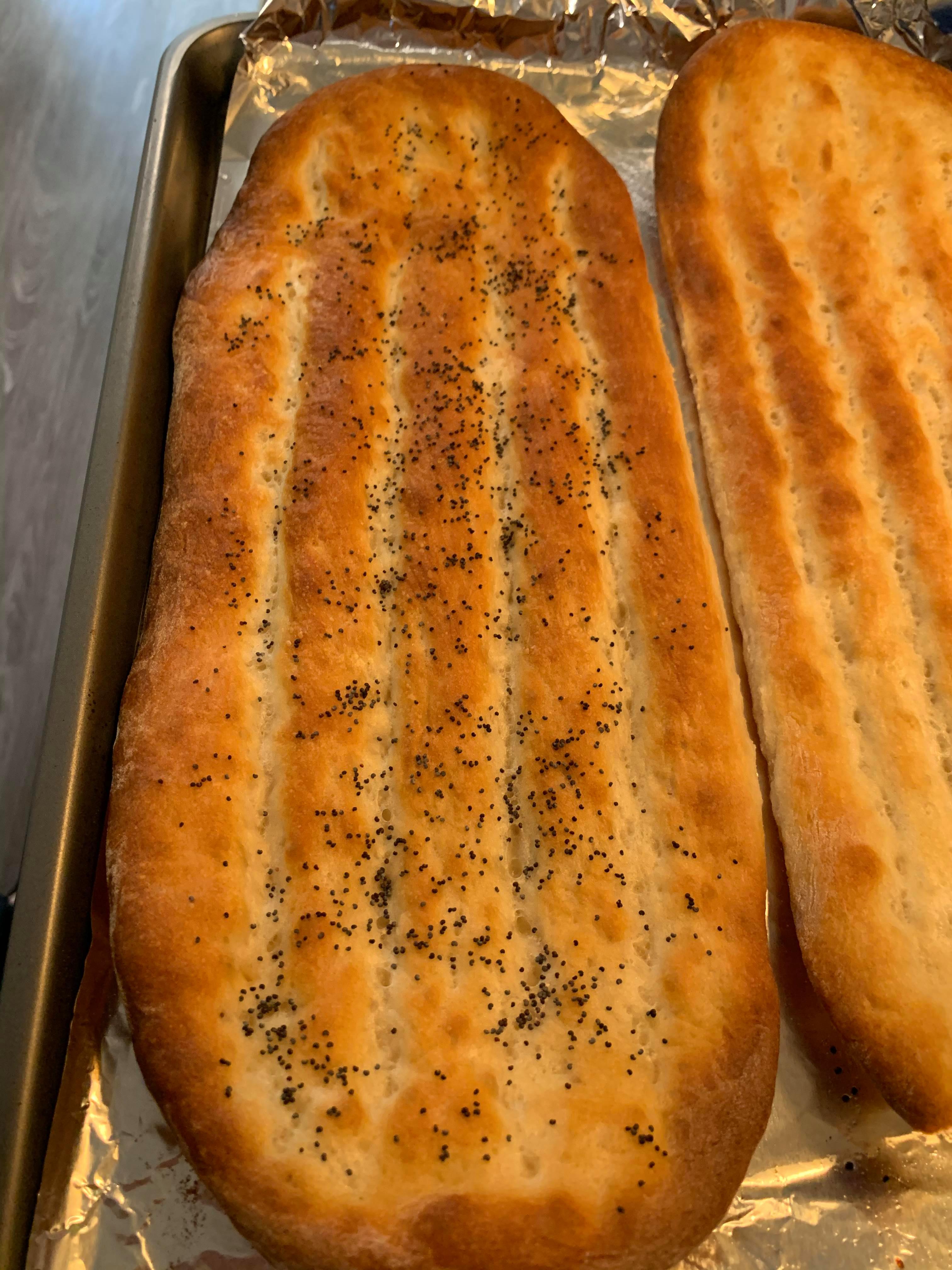Baking Bread During Pandemic
People are baking a lot of bread during COVID 19 pandemic. It makes sense since we are at home more often and baking bread is a wholesome activity to pass the time. It is also comforting, the hand kneading process, the smell of bread in the oven, and the fact that during this uncertain time, we still have warm bread on the table. People might say that Ph.D. students are not much affected by social distancing and restrictions since a Ph.D. degree does not usually come with much socializing anyway, but I think it is even more difficult for them to keep their body and mind healthy during these times, as the support circle for graduate students is much smaller than others and a great portion of graduate students in Canada are international students, far from family and dealing with travel restrictions.
Sangak
Sangak is a traditional Iranian bread, which means “little stone” in the Persian language. The name comes from how it is baked, on a bed of small hot stones in an oven. While small stones give Sangak a unique texture, I found that you can bake it in a home oven and get the same delicious taste. I got the recipe from a friend and changed it slightly to make the baking process faster. With these ingredients, you can bake two oven-size sangak bread.
 Sangak and meat broth, a traditional Iranian dish
Sangak and meat broth, a traditional Iranian dish
Ingredients
- 270 grams all-purpose flour (or 1 and a half cup + 5 tablespoons)
- 1 and a half cup warm water
- 1 and a half tablespoon quick-rise yeast
- 1 and a half tablespoon sugar
- 1 tablespoon salt
Take a large bowl and add yeast and a cup of warm water half a tablespoon sugar. Wait for 15 minutes until the yeast starts to make some bubbles on the surface of the water. Then, add 5 tablespoons of flour little by little and mix them thoroughly. This is no-knead dough, so after mixing, cover and let sit at room temperature for about 1 or 2 hours. Add 1 tablespoon sugar and 1 tablespoon salt to 1 and a half cup flour and mix them. Then, add the dry ingredients to the dough slowly and add half a cup of water while mixing them. Then, cover and let it rest for another hour.
Cut the dough in half. Wet your hands and the surface of your plate and spread out the dough into a rough triangle. You need a small bowl of water to wet your hands frequently. When it is done, spread poppy seeds or sesame seeds on the surface of the dough and put it in an oven, preheated to 410 degrees Fahrenheit, for about 15 to 20 minutes. You probably need to turn on the top heating element for about 2 minutes to have a golden top surface. Sangak is great with butter and feta cheese.
Barbari
Barbari is another traditional Iranian bread and the cooking process is very different from Sangak. Compared to Sangak, it has a crunchy surface and a light texture. You can cook two oven-sized Barbari bread with the following ingredients:
 Barbari with poppy seeds
Barbari with poppy seeds
Ingredients
- 4 and 1/4 cups all-purpose (or bread) flour
- 1 and 3/4 cup warm water
- 2 teaspoons active dry yeast
- 1 teaspoon salt
- 1 teaspoon sugar
- sesame seeds
For the glaze (coating)
- 1 teaspoon flour
- 1/2 cup water
- 1/4 teaspoon baking soda
Take a bowl and mix 3/4 cup warm water with active dry yeast and sugar, cover the top, and leave it for 15 minutes. The yeast mixture will look puffed up on top. Add 4 cups of flour and 1 teaspoon salt, mix it with the dough and add 1 cup of water little by little. Mix it well until you get a shaggy dough. Transfer it to a floured surface and start kneading the dough. The dough will be sticky at the beginning, add more flour to prevent sticking and get a smooth and elastic dough at the end. You should knead for about 5 minutes. Coat the dough with olive oil. Cover it with plastic wrap and put a large kitchen towel on top. Let the dough rest for an hour. The dough will rise to about twice the original volume.
Barbari has a glaze (coating). You can prepare it while waiting for the dough to rise. In a nonstick small pan, add 1 teaspoon flour and 1/4 cup cold water. Stir the flour well to break it up in the water. Add another 1/4 warm water and 1/4 teaspoon baking soda and still them to combine. Put it in the oven until it comes slowly to boil. Do not stop stirring until you get a uniform and thick glaze. Let it cool.
After an hour, take the cover and punch down the dough. Divide it in half and form it into two balls. Lightly flour a surface and put the dough on top. Dust it with flour and cover it for another 30 minutes. The dough will rise further.
On a floured surface, use your fingers to flatten one of the balls of dough and stretch it into an oval shape. Move the flattened dough to lightly floured parchment paper. Dip your fingers in a bowl of water and press them on the flattened dough to make several rows of indentations along the length of the dough. Do not tear the dough.
Brush the dough with the glaze and sprinkle sesame seeds. Let it rest for 5 minutes. Pre-heat oven to 400°F. Put the dough in the oven for about 17 minutes. When the sides of your bread are cooked, you can use the top heating element to make a golden crunchy top.
Beer Bread
The last one is not Iranian, but it is amazing since it contains beer. I found beer bread on Allrecipes and it was clear from the name that I should try it (the alcohol evaporates during the baking process, eeeh). I did not have fancy beers at home, so used Old Milwaukee beer, but it will be tastier if you use seasonal brews. You need the following ingredients
- 4 cups all-purpose flour
- 5 tablespoon brown sugar
- 1 and a half cans of beer
- 2 and a half tablespoons baking powder
- 1 teaspoon salt
Mix sugar, salt, baking powder and flour in a large bowl. Make a well in the center and add beer little by little and continue to mix. You do not need to knead the dough. Pour it into a greased loaf pan and bake at 350 degrees Fahrenheit for about 60 minutes. Beer bread has a crunchy top, with some unique texture, and is soft inside. I found them very delicious alone or just with a little butter spread.